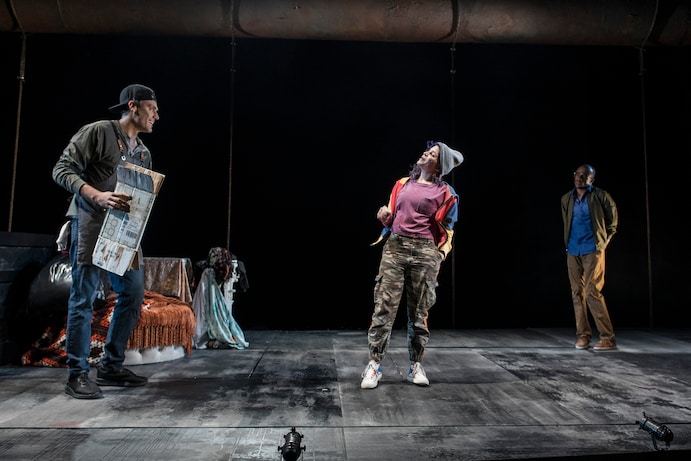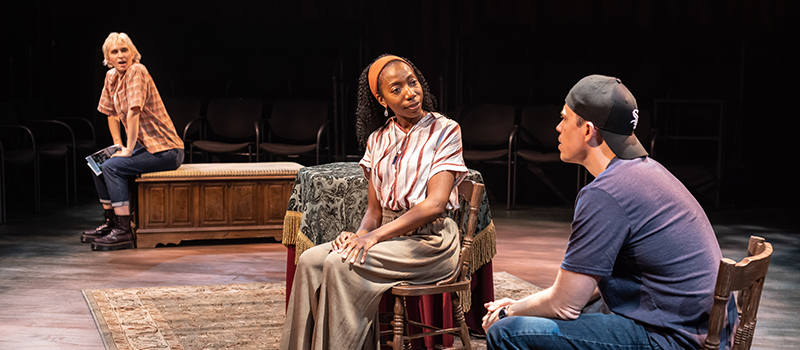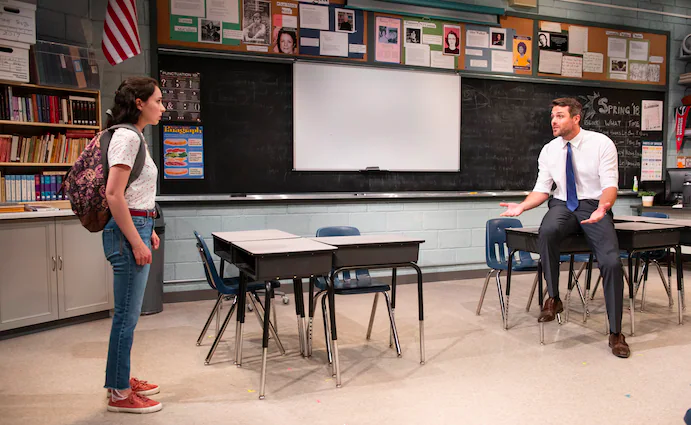The very best of these, ‘John Proctor Is the Villain’ at Studio Theatre, is nothing less than revelatory
by Peter Marks | May 20, 2022

Theater is working through a lot of trauma these days. In “There’s Always the Hudson,” Paola Lázaro’s world premiere play at Woolly Mammoth Theatre, a pair of group-therapy comrades played by Lázaro and Justin Weaks go on a revenge spree, seeking to settle scores with their abusers. In Chelsea Marcantel’s “The Upstairs Department,” making a global debut at Signature Theatre, a sister and brother (Annie Grove and Zach Livingston) travel to a community of healing psychics to process their father’s devastating covid death.
And in yet another world premiere in Washington, at Studio Theatre, Kimberly Belflower’s “John Proctor Is the Villain,” a classic play by Arthur Miller is the trigger for a classroom showdown between an accusatory teenager (Juliana Sass) and the charismatic high school teacher (Dave Register) whom everyone else in the little Georgia town seems to adore.
The qualitative impact of these offerings varies widely, from dazzling (“John Proctor”) to agreeable (“Upstairs Department”) to simply chaotic (“Hudson”). What these new works collectively reflect, though, is an American theater struggling to come to terms more energetically with what predators of both human and biological varieties are doing to us. The sense in all these plays is that we’ve yet to fully acknowledge how the psychological wounds of one member of the community can scar us all.
You can feel in “There’s Always the Hudson” an explosively nihilistic sense of frustration in Lázaro’s Lola and Weaks’s T, as they reach the conclusion that years of therapeutic intervention have done nothing to quell their anger and anxieties. On this desperate evening, they have resolved to end their lives by jumping off a bridge and into the Hudson, but not before confronting the men who raped them.
As directed in overheated style by Jess McLeod, the play descends haphazardly through the architecture of a meltdown, as Lola and T lash out indiscriminately at innocent bystanders as well as the men who actually caused their pain. The enormity of their traumas is evoked in cocaine-fueled tirades; raw, vulgar intimations of sex; and sets by Misha Kachman strewn with garbage. In a literal way, Lola and T are hellbent on retribution against a world that has trashed them.
The rage feels justifiably intense, but the play suffers from its demonstrative excess: The audience gets the drift all too soon. Some of the encounters — such as one in which Lola and T heap their own misplaced fury on another pathetic patient, played by Marilyn Torres — are histrionic. One particular scene, though, rings with daring truth. It occurs late in the play, when Lola shows up at the home of a relative, portrayed by Migs Govea, who raped her from a tender age. The encounter reveals a depth to Lázaro’s conception of “There’s Always the Hudson” that one wishes were accomplished with more consistency.

Marcantel’s “The Upstairs Department” at Signature plays out trauma in a minor key: Having emerged from a month-long medically induced coma, Livingston’s covid-surviving Luke now believes he has a kind of second sight, to go along with his second chance. He drags his non-believing sister, Grove’s impeccably agitated Colleen, to come with him to Lily Dale, N.Y., to study with a medium (Joy Jones). The goal is support for Luke’s newfound belief that he has followers in the afterlife, including his late father.
Holly Twyford directs the play with a smooth kind of “Okay, I’ll buy this” appreciation for Luke’s certitude; Jones, seen late last year in Arena Stage’s “Seven Guitars,” presides persuasively over the lessons with a placid mask — one that conceals her own tragedies. In concert with set designer Paige Hathaway and lighting designer Annie Wiegand, Twyford envelops Signature’s smaller space, the Ark, in mystical froufrou: Lamps and vintage photos above and on the walls glow in rhythmic patterns, as if illuminated to the beat of a symphony of ghosts.
It’s a play of soothing relatability, rather than commanding revelation. An audience under threat from viruses — and viral attacks on democracy — may find agreeable diversion in Luke’s awarding himself supernatural powers. You, as I did, may wish that in a world of disconsolate happenings, Luke and Colleen really could console themselves by moving objects with their minds.

The most exciting of these works has already been reviewed in this paper, by Celia Wren. I hereby add my endorsement to her glowing recommendation of Studio and Belflower’s “John Proctor Is the Villain,” one of the best plays I’ve seen since the return of live theater — and one that places a traumatic occurrence in a stunningly imaginative context.
The classroom of the outstanding Register’s Mr. Smith seems a kind of oasis of enlightenment for a one-stoplight town in northern Georgia (or maybe, we city slickers are just too quick to impose our own provincialism on rural America). His pupils — all seven evoked with thrilling authenticity under Marti Lyons’s stellar direction — are studying Miller’s “The Crucible” with a seeming preoccupation on the character of Abigail. She’s the teenage ringleader of a group of girls who fabricate accusations of witchcraft against upstanding townspeople of Salem, Mass., charges that lead to the execution of innocents.
Miller and Mr. Smith may have in mind an allegory for McCarthyism — the witch hunt for alleged communists of the 1950s. The brilliance of “John Proctor Is the Villain” lies in Belflower’s eye-opening turning of the tables: It’s the seduction by Proctor, ostensibly the play’s hero, of young Abigail that animates the dramatist’s plot. There’s a corresponding issue in Mr. Smith’s class; it’s dramatized in an astonishing turn by Juliana Sass as a girl harboring a secret pain she can no longer contain.
The playwright develops a parallelism between “The Crucible’s” Abigail and Sass’s Shelby that binds their fates in eloquent fashion. The explanation Belflower proposes for Abigail’s mad dancing in the forest is ideally analogized in the final scene. If any recent play might convince us of a continuum of abuse that stretches back to the earliest epoch of American culture, this is the one to do it.
There’s Always the Hudson, by Paola Lázaro. Directed by Jess McLeod. Sets, Misha Kachman; costumes, Ivania Stack; lighting, Barbara Samuels; sound, Tosin Olufolabi. With Elan Zafir. About 90 minutes. Through June 5 at Woolly Mammoth Theatre, 641 D St. NW. woollymammoth.net.
The Upstairs Department, by Chelsea Marcantel. Directed by Holly Twyford. Set, Paige Hathaway; costumes, Ivania Stack; lighting, Annie Wiegand; sound, Kenny Neal. About 90 minutes. Through June 12 at Signature Theatre, 4200 Campbell Ave., Arlington. sigtheatre.org.
John Proctor Is the Villain, by Kimberly Belflower. Directed by Marti Lyons. Set, Luciana Stecconi; costumes, Moyenda Kulemeka; lighting, Jesse Belsky; sound, Kathy Ruvuna. With Zachary Keller, Shawn Denegre-Vaught, Lida Maria Benson, Resa Mishina, Miranda Rizzolo, Jordan Slattery, Deidre Staples. Through June 12 at Studio Theatre, 1501 14th St. NW. studiotheatre.org.






